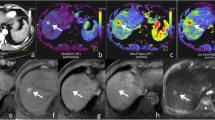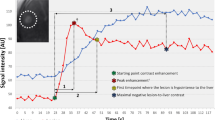Abstract.
Opinion is divided regarding the influence of iodized oil on MRI signal intensity of hepatic tumours treated with transcatheter arterial chemoembolization (TACE), in which lipiodol deposits. The aim of our study was to ascertain whether or not lipiodol directly influences the MRI signal intensity of hepatocellular carcinoma (HCC) treated by TACE and that of the surrounding liver. Thirteen patients with HCC were studied retrospectively. CT and MRI scans were performed both before and 3 months after TACE. The CT scan was performed to check whether embolized nodules contained lipiodol and how lipiodol was distributed within them. In addition, eight patients were examined prospectively within 7 days after TACE. In these patients a CT scan was performed to see how lipiodol was distributed in the neoplastic nodules and in normal hepatic parenchyma. In the first group of patients the contrast-to-noise (C/N) ratio on T1-weighted (T1W) images and the T2 relaxation time on T2-weighted (T2W) images were calculated for both neoplasm and surrounding liver. In the second group of patients we also measured the signal intensity of non-neoplastic liver that was either permeated or not permeated by lipiodol. The data were analysed with Wilcoxon's test. On T1W images we observed that the retention of lipiodol increased the C/N ratio in all the tumours studied within 1 week after TACE. In the patients studied 3 months after TACE the C/N ratio was not significantly increased. On T2W images lipiodol retention did not change tumour signal intensity. The iodized oil did not change the signal intensity of the liver surrounding the tumour, in comparison with the liver not permeated by lipiodol, on either T1W or T2W images. The results indicate that lipiodol does not modify the signal intensity in non-neoplastic hepatic parenchyma in which it is deposited; after 3 months it does not significantly affect the signal of the tumours that accumulated it. Lipiodol produces a high signal on T1W images over the first few days following TACE in those tumours in which it is deposited.
Similar content being viewed by others
Author information
Authors and Affiliations
Additional information
Received 21 June 1995; Revision received 22 January 1996; Accepted 24 January 1996
Rights and permissions
About this article
Cite this article
Santis, M., Alborino, S., Tartoni, P. et al. Effects of lipiodol retention on MRI signal intensity from hepatocellular carcinoma and surrounding liver treated by chemoembolization. Eur Radiol 7, 10–16 (1997). https://doi.org/10.1007/s003300050099
Published:
Issue Date:
DOI: https://doi.org/10.1007/s003300050099




